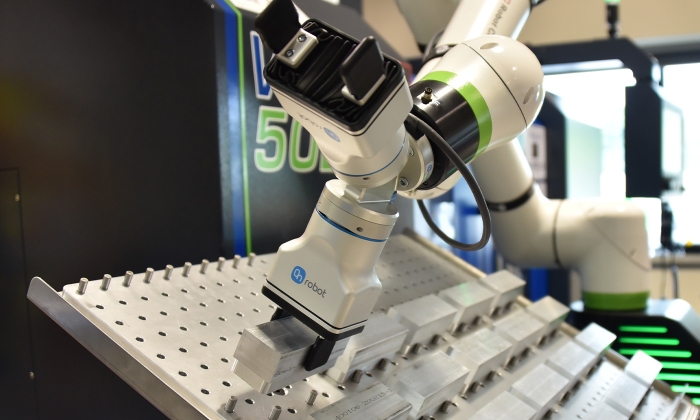Solve your labor shortages for good


Struggling to fill positions in manufacturing?
The good news is:
So are your competitors. The global working-age population is diminishing, and labour shortages are disrupting supply chains across the board.
Five out of ten positions for skilled workers in the U.S. manufacturing industry remain unfilled (1), while China is looking at a projected 30 million unfilled manufacturing jobs by 2025 (2). In Europe, almost three in ten manufacturing firms reported production constraints in 2022 due to a lack of workers (3).
The bad news is:
The competition for talent will get worse over the next decade as the large baby-boomer generation retires and the global birth rate continues to drop.
With nearly one fourth of the manufacturing workforce close to retirement age (4), small and medium-sized manufacturers need to tackle three challenges to win the fierce competition for talent:
- How do you meet demand with fewer workers?
- How do you win the recruitment game?
- And how do you retain older workers?
Three challenges. One obvious answer: Robotic automation.
Robotic automation increases productivity
To meet demand with fewer hands on deck, you need to produce more per worker. According to a McKinsey report (5), automation could raise productivity growth globally by as much as 0.8 to 1.4 percent per year.
Not only can robots work faster than humans; they handle predictable tasks accurately and consistently, increasing throughput and quality and decreasing downtime and labour costs.
It stretches the talent
Robotic automation frees human workers to perform more complex, value-adding tasks, allowing you to stretch the talent at your disposal. E.g., one worker can service and adjust several robotic applications rather than being stuck at one workstation for an entire shift.
It makes your manufacturing jobs more attractive
Arduous, repetitive and hazardous jobs abound in manufacturing. This is one reason why younger generations choose other career paths. By automating those tasks, you can offer more value-adding manufacturing jobs to win over the scarce talent.
It widens your talent pool
As robotic applications manage the physically challenging tasks, manufacturing jobs become accessible to a wider ability group, including older workers. In other words, your talent pool gets bigger.
It helps workers stay on the job longer
Collaborative robots can work alongside human workers, doing the heavy lifting and the repetitive motions that take the greatest toll on the human body through a long working life.
This means the long-term wear and tear on each worker is reduced and the risk of debilitating workplace injuries is minimized, empowering your workers to remain an active part of the workforce for longer.
Age diversity boosts productivity
Age may affect workers’ physical abilities, but it also brings experience, and better problem-solving and self-leading skills, which enhances performance. OECD research (6) shows that a 10 % share of older workers increases overall productivity by 1.1 %, and that the experience of older workers helps younger workers perform better, too.
To recap, manufacturers can leverage robotic automation to tackle labour shortage problems on three fronts:
- By boosting productivity, increasing the output per worker
- By making manufacturing jobs attractive to a wider talent pool
- By empowering older workers to stay on the job longer.
Paradoxically, robotic automation remains a largely untapped potential for many small and medium-sized manufacturers. While some automation barriers remain, many reservations about adoption are unfounded or out of touch with the technological advances in robotic automation.
What do the experts think?
Roberto Carrera, Sales and Service Manager for LAM Robotica and OnRobot partner gives us also his opinion on this topic:

“As a specialist in the field of robotics engineering, it is evident that automation offers a promising solution to address labor shortages in manufacturing. How the implementation of robotic systems can increase productivity, streamline operations, and address challenges related to talent availability are advantages we need to explore. It is important to know how our companies can collaborate with manufacturers and designers to implement automation solutions tailored to their specific needs.
While the benefits of automation are clear, it's essential to approach its integration with a forward-thinking mindset. Understanding and addressing potential technical and financial barriers, along with ensuring seamless integration into existing work environments, are crucial steps in maximizing the positive impact of automation.
In essence, automation presents a compelling pathway to enhanced efficiency and competitiveness in manufacturing. With careful planning and strategic execution, its benefits can be fully realized, driving innovation and success in the industry”.
Learn more:
Learn why you are not too small for robotic automation.
Learn how to crush the automation barriers for small and medium-sized manufacturers.
Learn how to control the biggest automation cost drivers.
Sources:

|
Cách phát triển doanh nghiệp của bạn với các ứng dụng cộng tác
Với sự khởi đầu của công cụ thông minh hơn và có khả năng thích ứng cao hơn, giờ đây rô-bốt có thể hoạt động với tốc độ, sức mạnh, sự an toàn và độ chính xác cao hơn, hoàn thành một loạt các nhiệm vụ trong khi vẫn tối đa hóa ROI. Tìm hiểu thêm về cách bạn có thể cho phép sản xuất nhanh hơn với chi phí thấp hơn bằng cách tải sách điện tử miễn phí của chúng tôi về.
NHẬN SÁCH ĐIỆN TỬ MIỄN PHÍ
|

|

